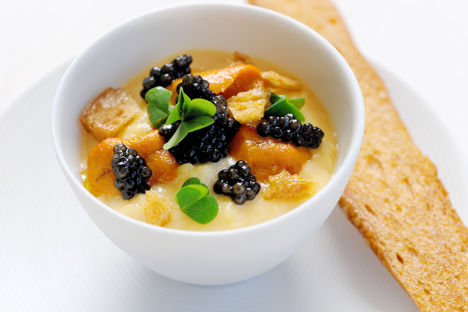Sea urchins are distinctive underwater creatures covered in spikes – you'll know it if you see one and you'll know it if you tread on one, too! They vary in colour and size. Some sea urchins are delicate, ping pong ball-sized creatures while some varieties can be melon-sized, with spines which are several inches long. The most commonly found in British restaurants is the purple sea urchin which grows in Pacific Waters or the Norwegian green – both of which are just a little smaller than tennis ball-sized.
Sea urchins have a long tradition in European cuisine – indeed they were supposedly served at Hercules' wedding to Hebe, the Greek goddess of youth. Unsurprisingly, they are most popular in coastal regions, from northern Norway to southern Spain. Sea urchins are also a great delicacy in Japanese cuisine, where they are known as 'uni', and often used in sushi, or served sashimi-style.
Only a small part of the sea urchin is eaten – the 'gonads' or sex organs, which run along the inside of the shell. The taste is delicate and musky. Sweet, with sea salt flavours, sea urchin is an ingredient which divides opinion and is prized as much for the smooth texture as its taste and aroma.
It's worth noting that the edible gonads are often incorrectly labelled 'roe'. They have a dark yellow-burned orange appearance, with a bumpy, tongue-like texture. The sea urchin gonads can be cooked and are sometimes puréed into a velvety-rich sauce but they are most often served raw.
It's not very easy to get hold of sea urchins. In the 1970s, national stocks were almost wiped out. But now sustainable sea urchin schemes are emerging, which raise urchins in a hatchery and then move them to rock pools. They are also available in well-connected fishmongers and fine food specialist shops.
How to cook with sea urchins
As with all seafood, it's important that the sea urchin is fresh. Smell is always the best indicator. They are are usually sold alive, and you can sometimes see the spines gently moving.
If you're dealing with a small sea urchin, use a good pair of kitchen scissors to cut round the 'equator'. When dealing with a larger sea urchin, it's most common to puncture one end, and then cut a small circle of shell out of the bottom, so that the majority of the shell stays intact.
Drain any dark-coloured liquid and then use a spoon to scoop out any other brown-black substance inside the shell. At this point, you can see how methodical sea urchin preparation is. Sea urchins are five-fold symmetrical creatures, with five yellow-orange gonads running up the inner wall. These look like little tongues, both in shape and also in texture. Rinse out the shell at this point, if needed, to have a clearer view.
Use the spoon to gently scrape the orange gonads away from the edge of the shell and then rinse them in fresh, or salt water. If they aren't being served immediately, then make sure that they remain chilled and use as soon as possible.
What sea urchin goes with
In terms of flavour pairing, think of sea urchin as you would think of caviar. They both have a delicate flavour with salty-oceanic notes. As with caviar, sea urchin is often simply spread on a biscuit or a piece of toast to showcase the flavours without any distraction. In Japanese cuisine, it is common to use sea urchin to top plain nigiri sushi or stirred into plain noodles. And in Italy, sea urchin is often stirred through a bowl of tagliatelle.
Chef Gary Jones uses scrambled eggs as the neutral backdrop to showcase both sea urchin and caviar, while chef Pascal Aussignac harnesses the sea salt flavours in a foam to dress his duck carpaccio.
Although sea urchin is an exciting ingredient to experiment with, it is possibly at its best when enjoyed in its purest form – eaten straight from of the shell. In many countries it's traditional to pair sea urchin only with a sip of the local liquor, be that Japanese sake or Greek ouzo.
Get in touch
Please sign in or register to send a comment to Great British Chefs.


